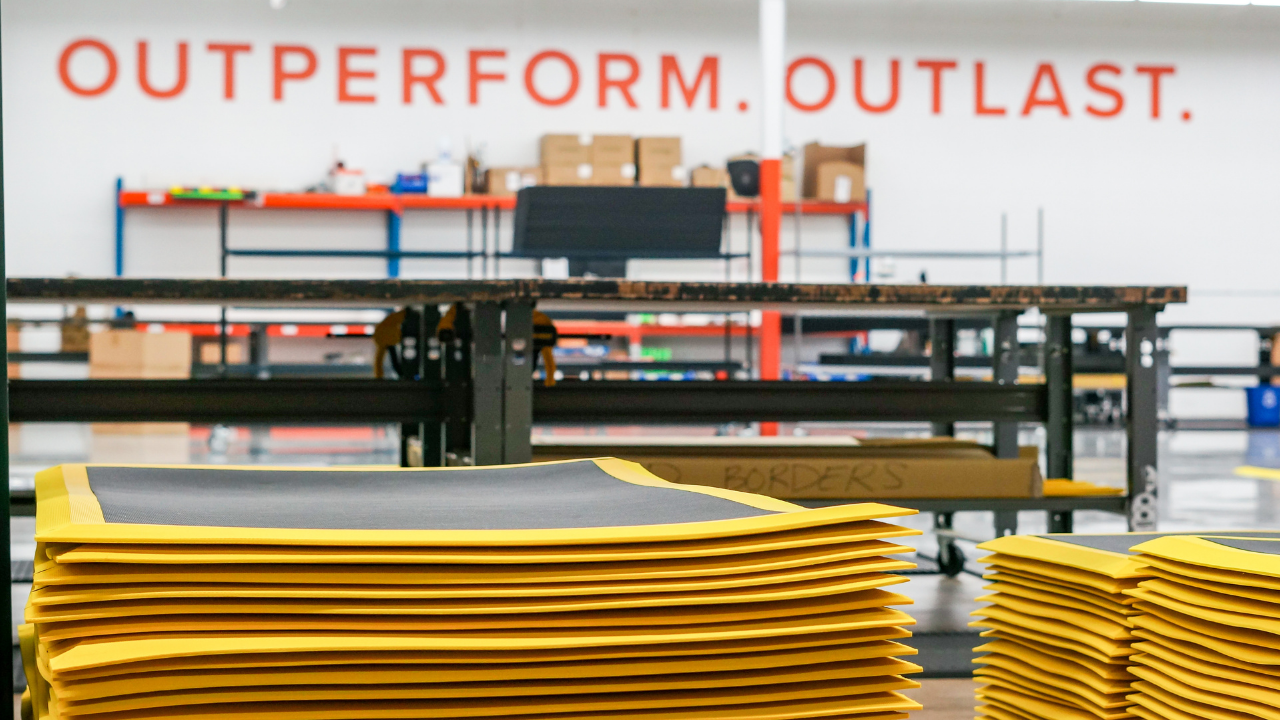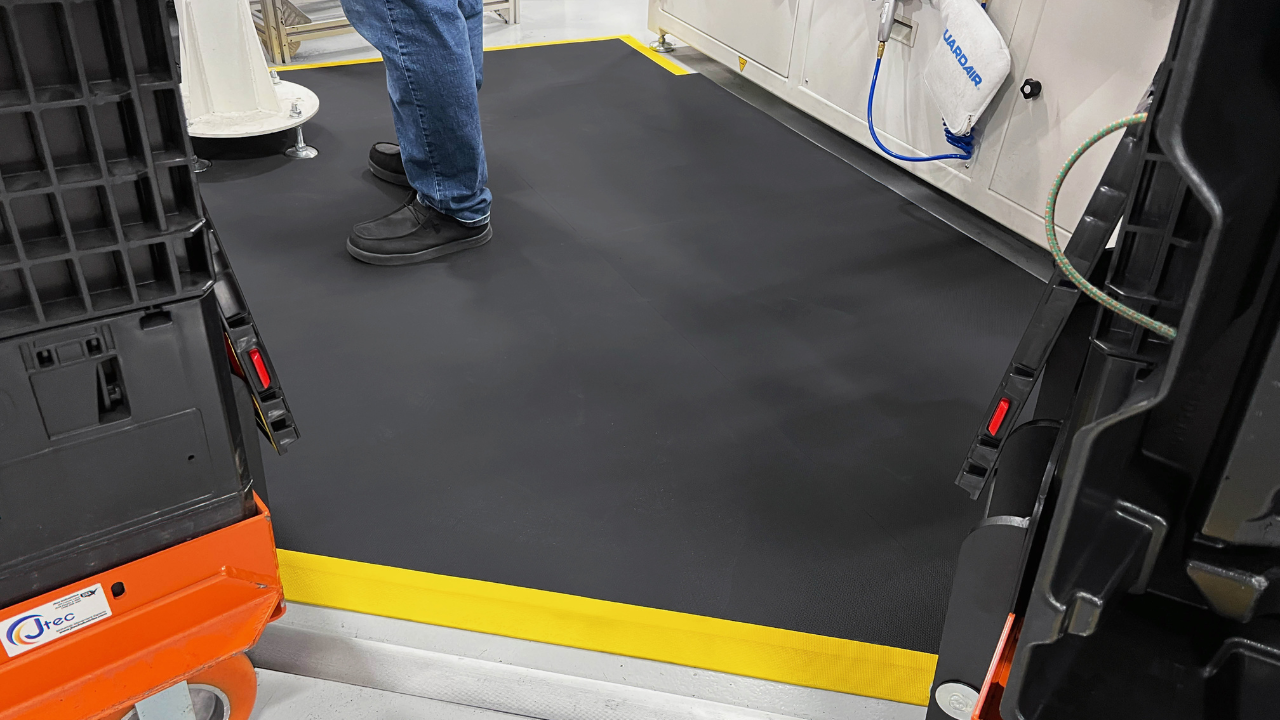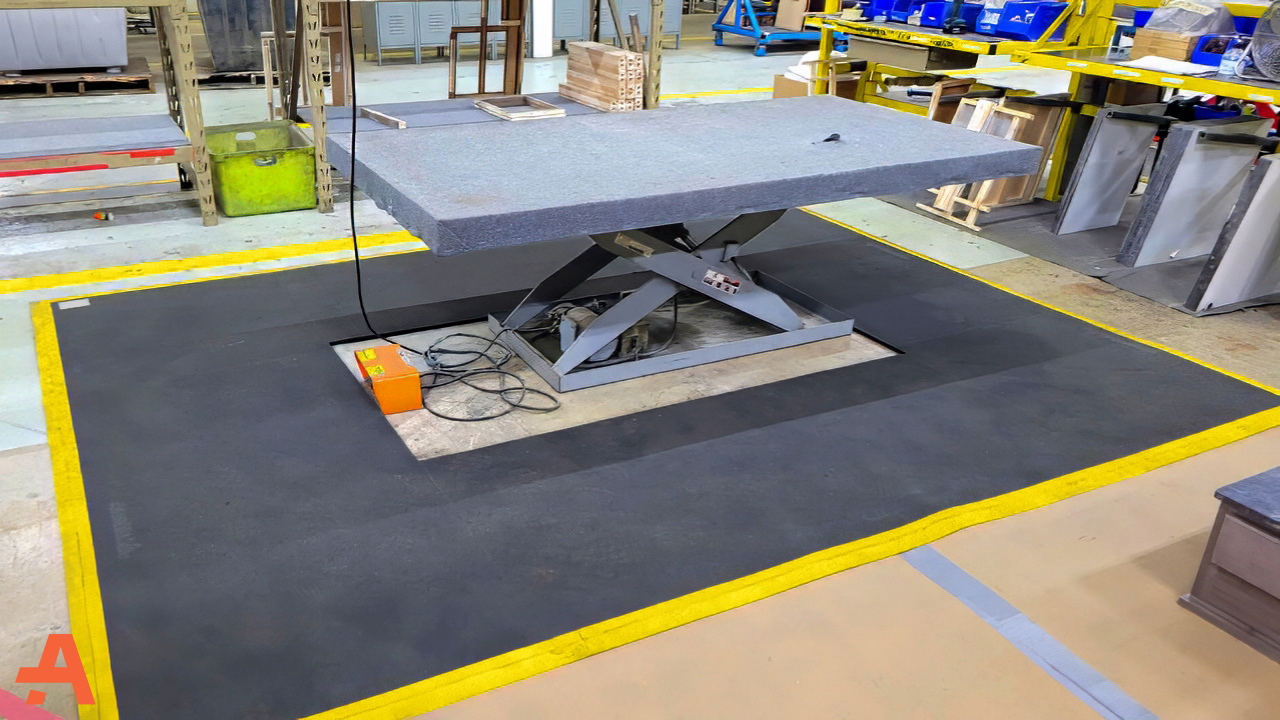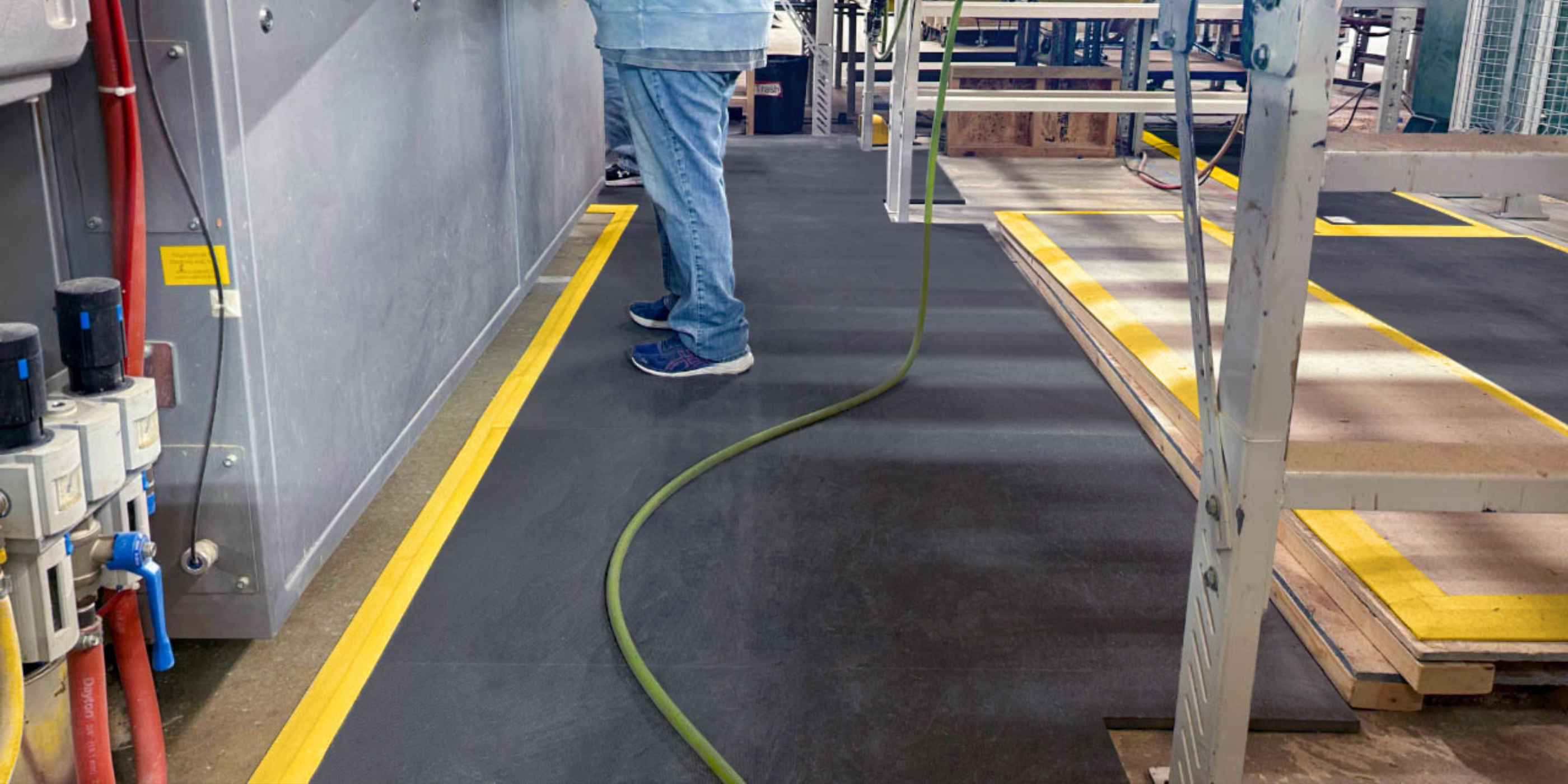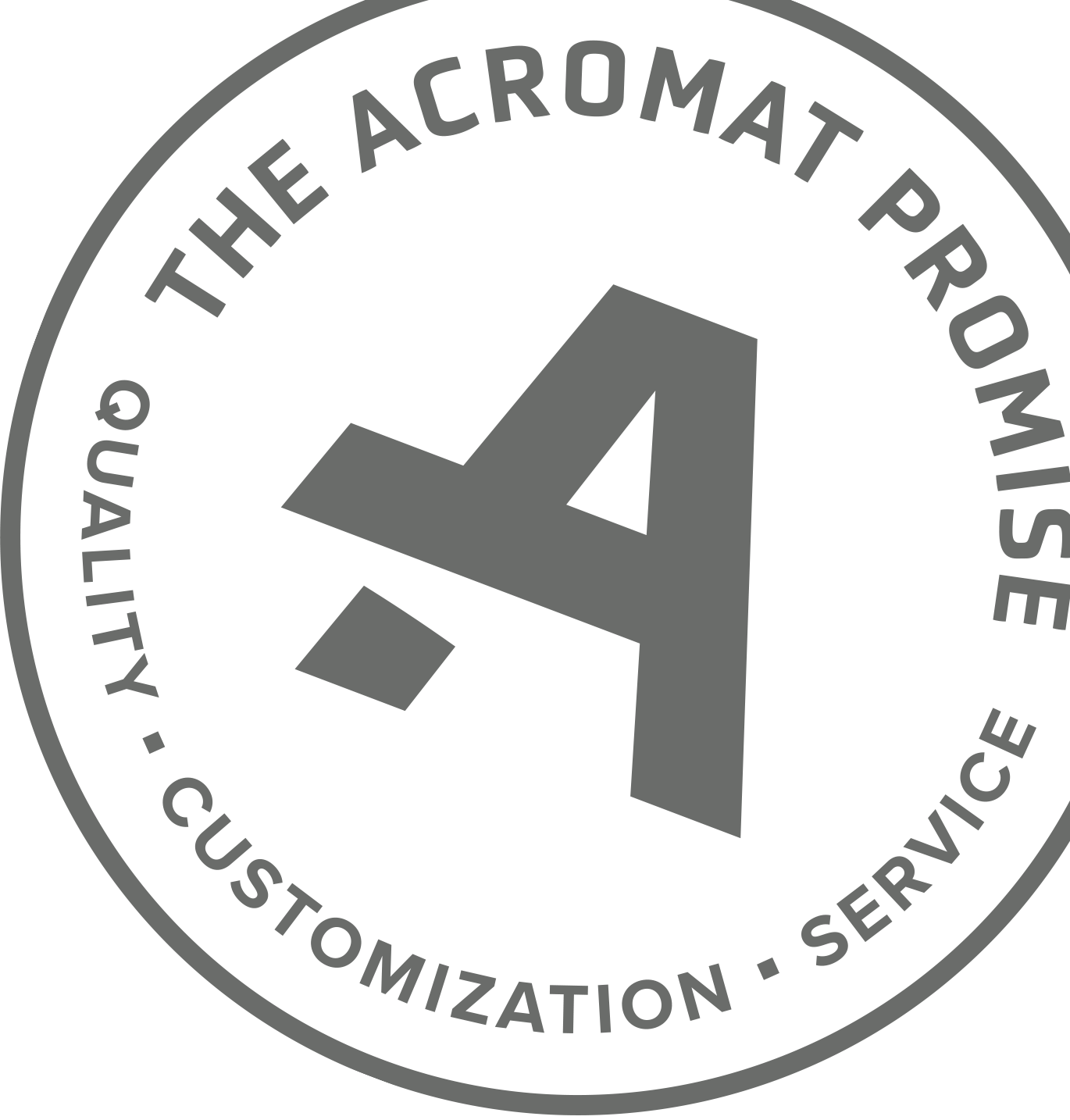Why aren't your anti-fatigue mats working? Why are they causing safety and health hazards rather than fixing them? Why are your team members frustrated with the state of their work environments? It’s quite simple, and it all starts here.
Here are 5 reasons your anti-fatigue mats aren’t working.
1. You have the wrong size and shape
40% of the safety leaders we surveyed say their No. 1 challenge with ergo mats is having to piece together standard rectangular mats to cover a work area. This creates preventable trip hazards, inconsistent surfaces, stacked and overlapped mats.
It also taxes your safety budget. Trying to fill a complex layout with 5+ rectangular mats costs exponentially more than a single custom mat designed to fit. Different mats age differently, leading to an inconsistent and reactive purchasing process.
 Left: Wrong shape and size, pieced together and overlapping mats. Right: One-piece custom anti-fatigue mat designed to fit. Crown Holdings.
Left: Wrong shape and size, pieced together and overlapping mats. Right: One-piece custom anti-fatigue mat designed to fit. Crown Holdings.
 Left: Pieced together mats, trip hazards, exposed grating. Right: Custom mats carefully designed to fit, non-slip backing prevents sliding. Spirit AeroSystems.
Left: Pieced together mats, trip hazards, exposed grating. Right: Custom mats carefully designed to fit, non-slip backing prevents sliding. Spirit AeroSystems.
 Left: Pieced together, sliding around mats. Right: Custom anti-fatigue mat with glove-like fit and ADA-compliant yellow borders. nVent.
Left: Pieced together, sliding around mats. Right: Custom anti-fatigue mat with glove-like fit and ADA-compliant yellow borders. nVent.
Custom one-piece mats designed to fit eliminate these issues entirely. No pieced together mats, no overlapping borders, and no ergonomic inconsistencies.
2. You selected the wrong material for your environment
52% of the safety leaders we polled expect their anti-fatigue mats to last 2+ years. Only 32% say they’re lasting the expected lifespan. Why the gap? You have the wrong mat material for your environment.
Erosion happens in wet/oily environments if your mats aren’t impervious to liquids. Flattening happens in areas with 24-hour foot traffic when mats are made from extruded PVC rather than molded 100% nitrile. Curling happens when you have borders greater than 20 degrees, or your mats are designed with the “waterfall” approach. The seams on your modular tiles will come apart in areas with metal shavings and sawdust accumulation.
The right material (and size/shape) will serve your people for years. The wrong material will break down quickly, overwhelm your budget, and require constant attention.
 Modular tiles aren't designed for heavy industrial environments. Here, the tiles have come apart quickly, creating trip hazards, due to particle accumulation.
Modular tiles aren't designed for heavy industrial environments. Here, the tiles have come apart quickly, creating trip hazards, due to particle accumulation.
 100% nitrile is impervious to liquids, chemicals, and products. The pure nitrile mat above is unaffected by particle buildup and can be cleaned easily.
100% nitrile is impervious to liquids, chemicals, and products. The pure nitrile mat above is unaffected by particle buildup and can be cleaned easily.
 Left: A traditional cable cover laid over this anti-fatigue mat creates a trip hazard. Right: The company replaced the hazard with a built-in, flat cable cover mat, eliminating the tripping risks while still protecting cords and cables.
Left: A traditional cable cover laid over this anti-fatigue mat creates a trip hazard. Right: The company replaced the hazard with a built-in, flat cable cover mat, eliminating the tripping risks while still protecting cords and cables.
3. You don’t test sample mats before buying
Every day we talk to safety managers, production supervisors, and manufacturing engineers about their pain points and the value of premium anti-fatigue mats. There's a lot of doubt, and rightly so. Most ergo mats don't hold up to the claims. Most break down quickly. Most sink underfoot. Most curl.
The best way to know you're getting what your team needs: Get samples and put them to the test. Beat the heck out of them. Then, do it some more.
Show don't tell
An EHS Manager asked how AcroMat mats hold up to water. We told them 100% nitrile is impervious to liquids. They didn't believe the claim; understandable, as they previously had several bad experiences. So, we submerged our mat in water for 72 hours and made a video of it. The mat weighed exactly the same 3 full days later – indicating no water had absorbed.
4. You settle for ambiguous warranties
I read a 600-word "lifetime" ergo mat warranty from one of the world's largest anti-fatigue suppliers. It reads, "installing may void warranty" and "does not include normal wear and tear." In brief, once you unbox and lay your mat on the production floor, the supplier can void the warranty immediately.
In this case, lifetime is nothing more than a buzzword to motivate the transaction.
Here's the AcroMat Lifetime Warranty in its entirety:
The AcroMat 100-1 Series, 100-Cleanroom Series, and 100-ESD Series anti-fatigue mats are covered by our best-in-class, full-replacement, Lifetime Performance Warranty.
This warranty guarantees
- The edges of your mat will NEVER curl.
- The mat will NEVER flatten or lose its ergonomic cushion.
That's it. No easy outs. Before your next purchase, look closely at the warranty. Get clarity in 1:1 conversations. Request a sample you can put to the test.
Better yet, ask the following questions:
- Does your warranty protect against curling?
- Does your warranty protect against flattening?
- Does your warranty protect against the tearing?
There should be no ambiguity, ever.
 Left: The "lifetime" warranty for this diamond-plate mat does not protect against curling. After 6 months, the mat is now a trip hazard with no recourse. Right: All AcroMat mats are guaranteed not to curl as part of our warranty.
Left: The "lifetime" warranty for this diamond-plate mat does not protect against curling. After 6 months, the mat is now a trip hazard with no recourse. Right: All AcroMat mats are guaranteed not to curl as part of our warranty.
5. You buy without feedback from your people
28% of the safety and production leaders we polled say they don't begin looking for new mats until there is a "complaint, injury, or close-call." If you wait for a complaint, the ergonomic injury already happened. Your employees are now left to deal with the physical and emotional consequences. Worse, your search for new mats is reactive.
Reactive searches lead to reactive purchases. Safety and production leaders end up skipping critical steps enroute to mats that are the wrong size and shape, the wrong material for the application, haven't been sampled, and come with ambiguous warranties.
Where should you start? Go. To. Your. People. Go down to the plant level. Stand on the mats yourself. Watch operators for over 30-60 minutes to see how they navigate their workstation, if the mat is big enough, if it slides, or if it's causing any trip and fall risks.
Ask, listen, and document:
- What would you change about the mat you're working on?
- How do you feel when you go home at night?
- Do you feel safe and physically supported?
- Do you have any pains you can't connect to an impact injury?
What’s the main takeaway?
Anti-fatigue mats don't have to be complicated. Sometimes we make them complicated, and in turn make the very things we're trying to improve worse – health, safety, productivity.
Simple changes can have a lasting impact. Dig deeper with the resources below.
--
Additional Resource: 10 Signs You Need New Anti-Fatigue Mats
